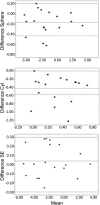Comparing habitual and i. Scription refractions
- PMID: 30755182
- PMCID: PMC6373049
- DOI: 10.1186/s12886-019-1053-x
Comparing habitual and i. Scription refractions
Abstract
Background: Many patients voice concerns regarding poor night vision, even when they see 20/20 or better in the exam room. During mesopic and scotopic conditions the pupil size increases, increasing the effects on visual performance of uncorrected (residual) refractive errors. The i.Scription refraction method claims to optimize traditional refractions for mesopic and scotopic conditions, by using the information that the Zeiss i.Profilerplus gathers of ocular aberrations (low and high order). The aim of this study was to investigate any differences between habitual and i.Scription refractions and their relationship to night vision complaints.
Methods: Habitual, subjective, and i.Scription refractions were obtained from both eyes of eighteen subjects. Low and high order aberrations of the subjects were recorded with the Zeiss i.Profilerplus. The root mean square (RMS) metric was calculated for small (3 mm) and maximum pupil sizes. Subjects rated their difficulty with driving at night on a scale of 1-10.
Results: There was a statistically significant difference between the habitual and i.Scription refractions on both the sphere and cylinder values [(t = 3.12, p < 0.01), (t = 5.39, p < 0.01)]. The same was found when comparing the subjective and i.Scription refractions [(t = 2.31, p = 0.03), (t = 2.54, p = 0.02)]. There were no significant differences found when comparing the sphere and cylinder values between the habitual and subjective refractions or on any combination of spherical equivalent refraction. The maximum pupil size of the subject population on this study, measured with the i.Profilerplus, was 4.8 ± 1.04 mm. Ten out of the eighteen subjects had discomfort at night with an average magnitude of 4 ± 2.7. Ratings of difficulty with night vision correlated with the change in spherical equivalent correction between the habitual and i.Scription refractions (p = 0.01). A sub-analysis of myopic subjects (n = 15) showed an increase in the significance of this relationship (p = 0.002).
Conclusions: The i.Scription method improves night vision by correcting the sphere and cylinder more precisely. There was a correlation between the amount of change in the cylinder value between habitual and i.Scription prescriptions and the magnitude of the reported visual discomfort at night.
Keywords: I.Profilerplus; I.Scription; Night myopia; Optical aberrations; Pseudomyopia.
Conflict of interest statement
Ethics approval and consent to participate
Study protocol and written informed consent was approved (protocol #AZ 761) by the Institutional Review Board of the Office of Research and Sponsored Program from the Midwestern University at Glendale, AZ. Written informed consent was obtained from every participant.
Consent for publication
Not applicable.
Competing interests
The authors declare that they have no competing interests.
Publisher’s Note
Springer Nature remains neutral with regard to jurisdictional claims in published maps and institutional affiliations.
Figures



References
-
- Ciuffreda KJ. Benjamin W. Borish’s clinical refraction. Philadelphia, PA: Saunders; 2006. Accommodation, pupil, and presbyopia; pp. 93–143.
MeSH terms
LinkOut - more resources
Full Text Sources

